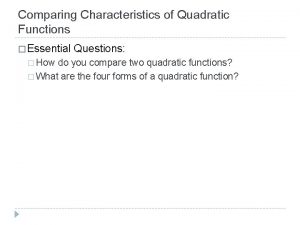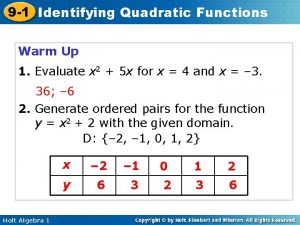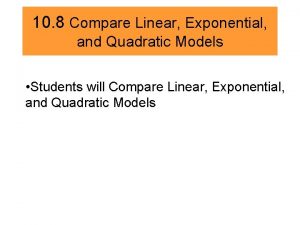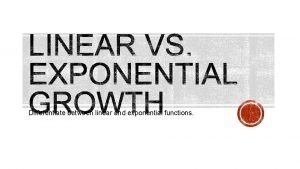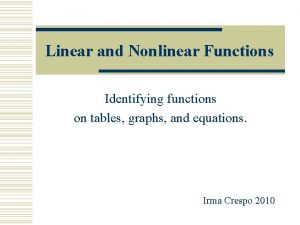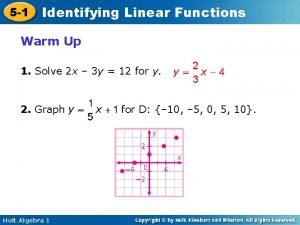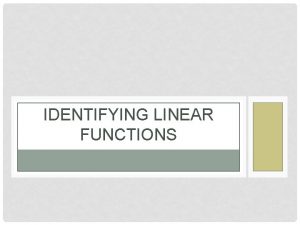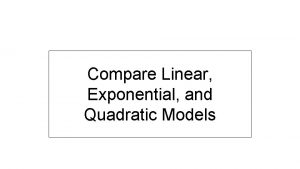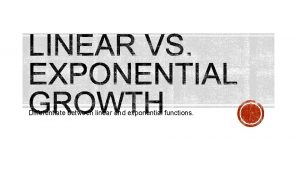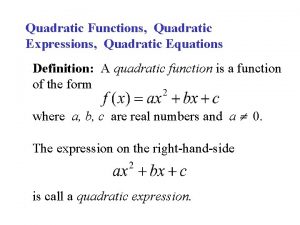Comparing Linear Exponential and Quadratic Functions Identifying from
















- Slides: 16

Comparing Linear, Exponential, and Quadratic Functions

Identifying from an equation: Linear Quadratic Exponential y = mx +b y = ax 2 + bx + c y = abx Has an x with no exponent Has an x 2 in the equation. Has an x as the exponent. (or exponent 1). Examples: y = 5 x + 1 y = ½x 2 x + 3 y = 6 y= 2 x 2 y= x 2 + 3 x – 5 x 2 +9 + 4 y = 7 Examples: y = 3 x + 1 y = 52 x 4 x + y = 13

Examples: LINEAR, QUADRATIC or EXPONENTIAL? a) y = 6 x + 3 b) y = 7 x 2 +5 x – 2 c) 9 x + 3 = y d) 42 x = 8

Identifying from a graph: Linear Quadratic Exponential Makes a straight line Makes a U or ∩ Rises or falls quickly in one direction

LINEAR, QUADRATIC, EXPONENTIAL, OR NEITHER? a) b) c) d)

Is the table linear, quadratic or exponential? Exponential Linear • Never see the same y value twice. • Can be written as: Next = Now + m, SA: b Quadratic • See same y more than once. • y changes more quickly than x. • Never see the same y value twice. • Can be written as: Next = Now b, SA: a

EXAMPLE 1 b. Identifying functions given a table of values x – 2 – 1 0 1 2 y – 2 1 4 7 10 3 3

EXAMPLE 2 Identifying functions given a table of values Does the table of values represent a linear function, an exponential function, or a quadratic function? a. x y – 2 0. 25 2 – 1 0. 5 0 1 2 2 2 4 2

EXAMPLE 3 Identifying functions given a table of values Determine which type of function the table of values represents. x – 2 – 1 0 1 2 y 2 0. 5 0 0. 5 2 – 1. 5 – 0. 5 1. 5

Is the table linear, quadratic or exponential? x y x y 1 5 1 0 1 3 2 9 2 -1 2 9 3 13 3 0 3 27 4 17 4 3 4 81 5 21 5 8 5 243

Identifying Regressions Using Shapes of Known Functions

Fitting Functions to Data The term regression pertains to the process of finding an equation for the relationship seen in a scatter plot. Regression is a generic term for all methods attempting to fit a model to observed data in order to predict new values. Steps for finding a regression: 1. Create a scatter plot:

Creating a Scatter Plot 9 Zoom Stat

Go to STAT, arrow right to CALC, and arrow down for regression equation choices.


 Quadratic relationship table
Quadratic relationship table Comparing quadratic functions
Comparing quadratic functions Chapter 4 lesson 8 quadratic functions
Chapter 4 lesson 8 quadratic functions Quiz 8-1 graphing quadratic equations
Quiz 8-1 graphing quadratic equations 9-1 identifying quadratic functions
9-1 identifying quadratic functions What is linear exponential and quadratic
What is linear exponential and quadratic Linear vs quadratic vs exponential
Linear vs quadratic vs exponential Difference between linear and exponential
Difference between linear and exponential Identifying and non identifying adjective clauses
Identifying and non identifying adjective clauses Non identifying adjective clauses examples
Non identifying adjective clauses examples Information essential
Information essential How can you identify a linear function
How can you identify a linear function Linear and nonlinear tables worksheet
Linear and nonlinear tables worksheet 5-1 identifying linear functions answer key
5-1 identifying linear functions answer key Modeling with quadratic functions
Modeling with quadratic functions Graphing linear and exponential functions
Graphing linear and exponential functions Chapter 3 linear and quadratic functions
Chapter 3 linear and quadratic functions

